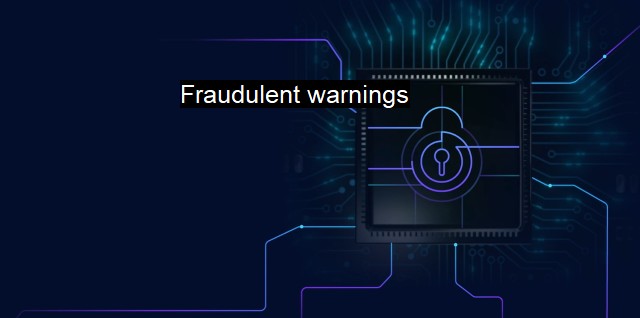What are Fraudulent warnings?
Don't Fall for It: How to Recognize and Avoid Fraudulent Warnings in Cybersecurity and Antivirus
One term is drawn into sharp focus: 'fraudulent warnings'. This is a common ploy that lures individuals by presenting an illusion of safety concern while intending to deceive or exploit them. When applied to cybersecurity and antivirus, fraudulent warnings pose a significant danger and threaten the integrity of personal, corporate, and even global data systems.First, let's unpack what fraudulent warnings mean. Simply put, fraudulent warnings are deceptive messages that falsely alarm users about non-existing threats or problems. They are created to induce panic or worry in the user, which may lead to impulsive actions that can jeopardize their cybersecurity. These fake warnings often mimic genuine security alerts to make them appear reliable and render the deception highly effective. Some common examples include fake antivirus software alerts, bogus tech-support scams, scam emails, false bank notifications, and fraudulent system warnings.
The primary aim of fraudulent warnings is to trick users into performing an action that would compromise their cybersecurity. This action often involves downloading and installing malicious software (malware) disguised as troubleshooting tools or antivirus solutions. In some instances, it could lead victims to fraudulent websites where their sensitive information such as login credentials, credit card details, and vital personal data are stolen. In certain cases, fraud warnings enforce “ransom” situations, where victims have their data encrypted and access denied until they cough up a significant sum of money.
A quintessential example of fraudulent warning is fake antivirus software or 'scareware'. These typically appear as pop-up windows on your computer screen bearing messages like, "Your system is at risk," or "Your computer is heavily infected - remove threats immediately." They aim to scare users into purchasing and installing 'antivirus software' that, in reality, is malicious software designed to cripple their system or pilfer valuable data.
On a broader scale, fraudulent warnings can be illustrated through Phishing – a cybercrime tactic where individuals are targeted by email, telephone, or text messages that appear to come from trustworthy firms. These feigned warnings direct recipients to validate personal information ostensibly due to a fake security concern. In doing so, they successfully trick people into divulging sensitive personal data, which is then used to access important accounts, resulting in financial loss, and even identity theft.
From the aforementioned examples, it's clear that ignorance is the weak link exploited by fraudulent warnings. Therefore, the only pragmatic countermove to these costly intrusions is cultivating a culture of awareness and knowledge about such dangers.
To steer clear of fraudulent warnings, use licensed security applications from trusted vendors and keep these applications updated. Disabled pop-ups and unsolicited downloads go a long way in curtailing attacks. It’s also advisable to ignore and discard any unusual email, text, or call that requests personal data. Many cybersecurity firms advise on 'No Clicking', meaning documents or links from unverified sources should be avoided. It's also beneficial to regularly back-up your data—an insurance against ransomware attacks. Password security should also be paramount: combining both upper and lower case letters, adding numbers or unique characters can fortify password strength.
In sum, fraudulent warnings are deceitful tactics by nefarious actors, aiming to manipulate users by injecting false concerns about their cybersecurity. This manipulation leads to people taking harmful actions such as downloading malware or divulging personal data that could expose them to a myriad of cyber threats. In these times, cultivating a proactive mindset and robust digital hygiene routines offer the best line of defense against these threats. It is an enduring endeavor to unmask the truth behind the veil of these fraudulent warnings and ridicule the underhanded tactics of contemporary digital tricksters.

Fraudulent warnings FAQs
What are fraudulent warnings in cybersecurity?
Fraudulent warnings in cybersecurity are false notifications that appear to be from legitimate sources, such as antivirus software or operating systems. These warnings are designed to trick users into taking certain actions, such as downloading malware or providing personal information.How do fraudulent warnings work?
Fraudulent warnings typically work by exploiting vulnerabilities in operating systems or web browsers to display fake alerts that appear to be legitimate. The alerts may claim that the user's computer is infected with a virus or malware and urge them to take immediate action. These actions often involve downloading and installing additional software or providing sensitive information such as credit card numbers, passwords, or social security numbers.What are some common signs of fraudulent warnings?
Some common signs of fraudulent warnings include urgent messages, poor grammar or spelling, unsolicited emails, and suspicious website URLs. These warnings may also contain alarming messages intended to scare users into taking action, such as claiming that their computer is at risk of being permanently damaged or their identity being stolen.How can I protect myself from fraudulent warnings?
To protect yourself from fraudulent warnings, it is important to keep your operating system and web browsers up to date with security patches and software updates. You should also use reputable antivirus software and be cautious of unsolicited emails or pop-up messages. If you are unsure of the legitimacy of a warning message, it is best to do some research or seek assistance from a tech professional.| | A | | | B | | | C | | | D | | | E | | | F | | | G | | | H | | | I | | | J | | | K | | | L | | | M | |
| | N | | | O | | | P | | | Q | | | R | | | S | | | T | | | U | | | V | | | W | | | X | | | Y | | | Z | |
| | 1 | | | 2 | | | 3 | | | 4 | | | 7 | | | 8 | | |||||||